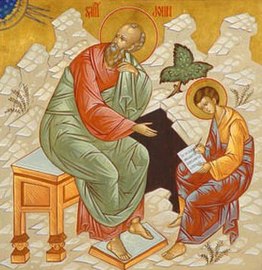Top Qs
Timeline
Chat
Perspective
July 28 (Eastern Orthodox liturgics)
From Wikipedia, the free encyclopedia
Remove ads
July 27 - Eastern Orthodox Church calendar - July 29

All fixed commemorations below are celebrated on August 10 by Old Calendar.[note 1]
For July 28th, Orthodox Churches on the Old Calendar commemorate the Saints listed on July 15.
Saints
- Martyr Julian of Dalmatia (c. 138-161)[1][6][7][8]
- Martyr Eustathius the Soldier, of Ancyra (c. 316)[1][3][5][9][10][note 3]
- Martyr Acacius of Miletus (c. 321)[1][3][5][12][13][note 4]
- Martyr Drosis (Drosida, Drosa), by being cast into a golden crucible.[3][5][14][15][note 5] (see also: March 22)
- Martyr Auxentios, of Laodicea in Phrygia.[15][16]
- Venerable Irene Chrysovolantou of Cappadocia, Abbess of Chrysovalantou (912)[1][3][5][6][17][18][19][note 6][note 7][note 8]
- Venerable Paul of Xeropotamou, on Mount Athos (820 or 996)[1][3][5][6][8][21][22]
- Saint George the Builder, of Iveron, Mt. Athos (1029 or 1033)[1][6][23]
Remove ads
Pre-Schism Western saints
- Martyrs Nazarius and Celsus, martyrs in Milan in Italy under Nero (c. 68)[24][25][note 9] (see also: October 14)
- Saint Victor I, born in North Africa, he was Pope of Rome for ten years from 189-198 (198)[24][26][note 10]
- Saint Peregrinus, a priest near Lyons in France at the time of St Irenaeus and during the persecution under Severus (2nd century)[24][note 11][note 12]
- Saint Camelian, successor of St Lupus as Bishop of Troyes in France from 478 (c. 525)[24]
- Saints Ursus and Leobatius (Leubais), Brother-Abbots, of Gaul (c. 500)[1][6] (see also: July 30)
- Saint Samson of Dol, Bishop of Dol, in Brittany (c. 565)[1][5][6][24][27][28][29][note 13][note 14]
- Saint Banthus of Trier, Bishop of Trier in Germany (7th century)[30] (see also: July 25)[31]
- Saint Arduinus (Ardwyne), patron-saint of Trepino in the south of Italy (7th century)[24][27][note 15][note 16]
- Saint Lucidus of Aquara, a monk of St Peter's near Aquara, in the south of Italy (c. 938)[24][note 17]
- Saint Lyutius, a monk at Montecassino who died as a hermit at La Cava Abbey in Italy (c. 1038)[24]
Remove ads
Post-Schism Orthodox saints
- Venerable Moses of the Kiev Caves, Wonderworker (13th-14th centuries)[1][5][6][8][15][32][note 18]
- Saint Anthony, Bishop of Rostov, Yaroslavl, and Belozersk (1336)[1]
- New Martyr David of Aleppo (1660)[1]
- Saint Pitirim, Bishop of Tambov (1698)[5][6][8][33][34][note 19]
- New Martyr Christodoulos of Kassandreia (1777)[3][5][6][35]
New martyrs and confessors
- New Hieromartyr Nicholas Ponomarev, Deacon (1918)[6][8]
- New Hieromartyr Basil (Erekaev), Hieromonk of Sarov Monastery (1937)[1][6][36]
- Virgin-martyrs Anastasia Kamaeva[37] and Helen Astashkina[38] (1937)[6]
- Martyrs Aretha Yeriomkin,[39] John Lomakin,[40] John Selmanov,[41] John Milioshkin[42] (1937)[6]
- Virgin-martyr Maura Moisieva (1937)[6][8]
- New Hieromartyr Ignatius (Bazyluk) of Jabłeczna, in Chelm and Podlasie, Poland (1942)[1][6][note 20] (see also: August 9)
Other commemorations
- Consecration the Temple of the Most Holy Theotokos in the Quarter of Deaconess.[5][15][43]
- Synaxis of the Saints of Tambov (1988)[1][6][44][note 21]
- Repose of Abbess Daria of Sezenovo Convent (1858)[1][note 22]
- Translation of the relics of Saint Jacob the New Chozebite (1960)[45] (see also: August 5)
Icons
- Icon of the Most Holy Theotokos "Directress of Smolensk", brought from Constantinople (1046)[1][5][6][46][note 23]
- Icons of the Most Holy Theotokos "Grebensk" (1380),[47] "Kostroma" (1672), and "Umileniye" ("of Tender Feeling") of Diveyevo Convent (1885),[1][5][8][48] before which St. Seraphim reposed.[6][8]
- Reverence list of an "Smolensk" Icon of the Mother of God:[6][8]
- "Ustiug" (1290)
- "Vidropusskaya" (15th century)[49]
- "Voronin" (1524) (see also: June 15)
- "Xristoforov" (16th century)
- "Suprasl", Poland (16th century)[1][8][50]
- "Yugskaya" (1615)
- "Igritsky" (1624)[51]
- "Shuiskaya" (1654-55)
- "Sedmiezersk" (Seven Lakes) (17th century)[1]
- "Sergievsk" (Trinity-St. Sergius Lavra) (1730)
Remove ads
Icon gallery
- St. John the Evangelist with Prochorus.
- St. Nicanor the Deacon.
- Venerable Irene Chrysovolantou of Cappadocia.
- Venerable Paul of Xeropotamou, on Mount Athos.
- Martyr Nazarius.
- Venerable Moses the Wonderworker of the Kiev Caves.
- Saint Pitirim, Bishop of Tambov.
- New Hieromartyr Ignatius (Bazyluk).
- Smolensk Icon of the Mother of God (Dionisius the Wise, 1482).
Remove ads
Notes
- The notation Old Style or (OS) is sometimes used to indicate a date in the Julian Calendar (which is used by churches on the "Old Calendar").
The notation New Style or (NS), indicates a date in the Revised Julian calendar (which is used by churches on the "New Calendar"). - Kontakion of the Righteous One. Third Tone:
Leaving all the world behind, with its impermanent glory, thou wast wedded unto Christ, the King immortal and holy, bringing Him as precious dowry thy maiden beauty and thy trophies won through abstinence over demons. O Irene, our righteous Mother, entreat thy Bridegroom to show His mercy to us."[20] - "At Milan, the birthday of the holy martyrs Nazarius and a boy named Celsus. While the persecution excited by Nero was raging, they were beheaded by Anolinus, after long sufferings and afflictions endured in prison."[11]
- Born in Wales, he became a disciple of St Illtyd at Llantwit Major and then for a time was monk and abbot of the monastery on Caldey Island. He left Caldey and visited Ireland. Then he went to Cornwall and was consecrated bishop by St Dubricius. Finally he crossed to Brittany and spent the rest of his life enlightening that country, basing himself at Dol. He was one of the greatest missionaries of his century.
- According to some he was one of four English pilgrims who reposed in this region in the seventh century.
- See: (in Italian) Arduino di Ceprano. Wikipedia. (Italian Wikipedia).
- See: (in Italian) Lucido di Aquara. Wikipedia. (Italian Wikipedia).
- See: (in Ukrainian) Мойсей Чудотворець. Википедии. (Ukrainian Wikipedia).
- See: (in Russian) Питирим (епископ Тамбовский). Википедии. (Russian Wikipedia).
- See: (in Polish) Ignacy (Bazyluk). Wikipedii. (Polish Wikipedia).
- See: (in Russian) Собор Тамбовских святых. Википедии. (Russian Wikipedia).
- See: (in Russian) Сезёновский Иоанно-Казанский монастырь. Википедии. (Russian Wikipedia).
- See: (in Russian) Смоленская икона Божией Матери. Википедии. (Russian Wikipedia).
Remove ads
References
Sources
Wikiwand - on
Seamless Wikipedia browsing. On steroids.
Remove ads










